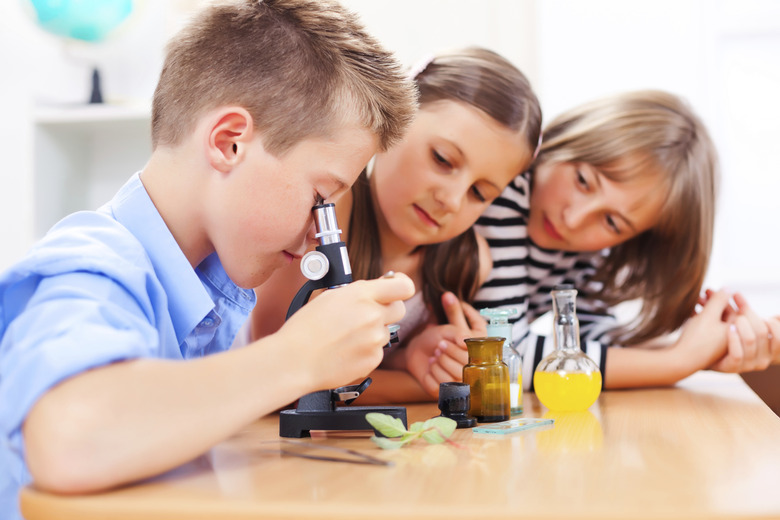Easy Kids' Science Fair Experiments About Germs
A science fair gives children the chance to put their scientific skills and knowledge to the test, as well as show them off to others. Germs is one topic with numerous possibilities, from how germs are spread to the potential dangers of certain germs. Help your child choose a topic and experiment that can be replicated at the science fair so her audience receives a well-rounded education about the science of germs.
Glitter Germs
Glitter Germs
Illustrating how quickly germs are spread is a useful and entertaining science fair activity that can be done with audience members. Give each person a small squirt of hand sanitizer or a spritz of water from a spray bottle. Immediately have the participants roll their damp hands in trays of glitter set up on the demonstration table. The glitter will act as the germs in the experiment. Ask the participants to shake hands with people who don't have glitter on their hands and to touch items around the area, such as the edge of the table or a purse handle. Have the audience observe how easily the glitter was transferred from hands to other surfaces, and remind them that washing their hands will help stop this transfer. Replace the glitter with flour or cornstarch for another option.
Where the Germs Are
Where the Germs Are
With some advance preparation, a science fair project can demonstrate what surfaces have the most germs. A child needs to collect four slices of potato and rub the flesh part of the potato on different surfaces, such as a door knob or toilet seat, without touching the flesh part. Again, without touching the flesh part that's been rubbed on the surface, each potato slice should be placed in individual zip-top bags, labeled with the appropriate surface. Place the bags in a dark closet for a week, and then observe which ones are growing things, which indicates the presence of germs. During the science fair, the student can display the potato slices and describe the process of the experiment. As an alternate experiment, a child can rub the potato slices along his tongue before and after brushing his teeth to demonstrate the importance of good oral hygiene.
Regular, Antibacterial or Sanitizer
Regular, Antibacterial or Sanitizer
An experiment that illustrates the effectiveness of regular soap, antibacterial soap and hand sanitizer is another good science fair project. To conduct the experiment, the student washes his hands with regular soap and then rubs them in a petri dish. Later, after using his hands for awhile, the student washes them with antibacterial soap and rubs them in a petri dish. After he has used his hands several times, he will wash them with hand sanitizer and rub them in a petri dish. The student will then leave the petri dishes for a week or two and see which one grows the most visible mold or bacteria. This will demonstrate if one product is superior or inferior to another. Instead of petri dishes, the student can rub his hands on bread slices and slide them into plastic zip-top bags to get similar results.
Grow Some Bacteria
Grow Some Bacteria
For this experiment, the student will use cotton swabs to rub a variety of surfaces to determine if hand sanitizer is effective at killing germs. Once the swabs have been rubbed on surfaces, such as the cafeteria floor, the student's desk and a cell phone, they're rubbed in petri dishes that contain agar, which, according to well-known scientist Steve Spangler, is food for potential bacteria. These petri dishes are available at many teacher supply stores. The student will actually need two petri dishes for each swab. One will be the control, and the other will be rubbed with hand sanitizer immediately before rubbing the cotton swab inside. One swab from a cell phone will be rubbed in the control petri dish, and the same swab will also be rubbed in one with hand sanitizer. The petri dishes will be left in a warm, dark place to grow for several days so the student can compare the amount of growth in the control dishes to the amount of growth in the dishes with hand sanitizer.
Cite This Article
MLA
Ipatenco, Sara. "Easy Kids' Science Fair Experiments About Germs" sciencing.com, https://www.sciencing.com/easy-science-fair-experiments-germs-7973072/. 24 April 2017.
APA
Ipatenco, Sara. (2017, April 24). Easy Kids' Science Fair Experiments About Germs. sciencing.com. Retrieved from https://www.sciencing.com/easy-science-fair-experiments-germs-7973072/
Chicago
Ipatenco, Sara. Easy Kids' Science Fair Experiments About Germs last modified August 30, 2022. https://www.sciencing.com/easy-science-fair-experiments-germs-7973072/
